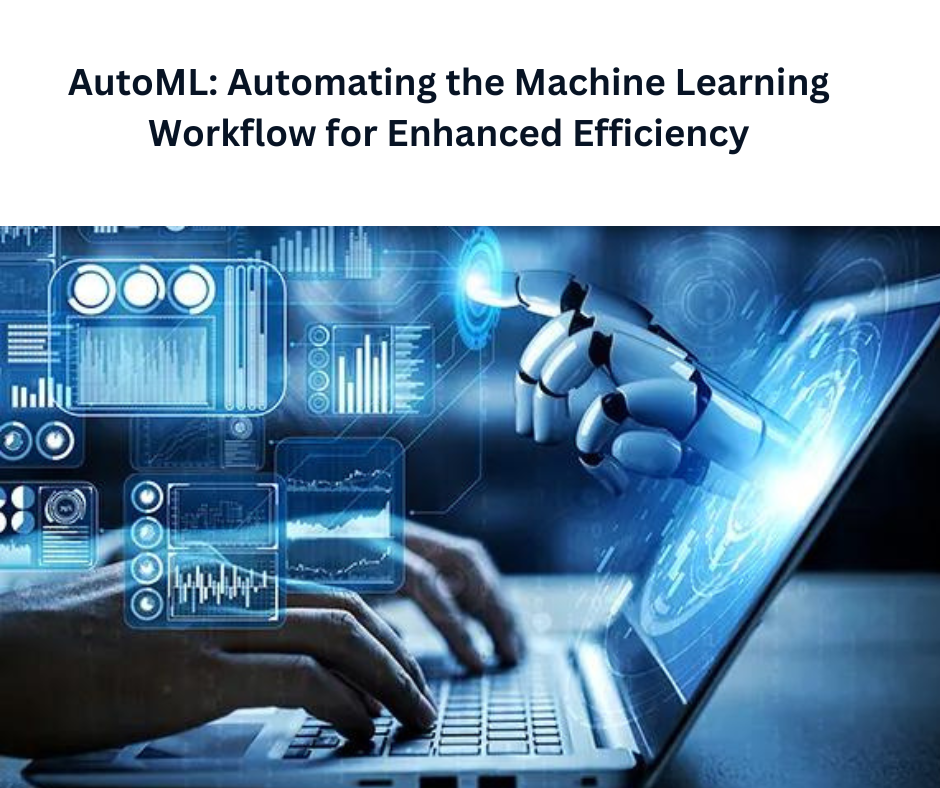Auto ML: Automating the Machine Learning Workflow for Enhanced Efficiency
 Ruhi Parveen
Ruhi Parveen
Introduction to AutoML
Automated Machine Learning (AutoML) is a groundbreaking technology designed to streamline the machine learning process. By automating tasks that typically require specialized knowledge, AutoML allows users with varying levels of expertise to create machine learning models. This technology enhances efficiency, reduces human error, and accelerates the deployment of machine learning solutions.
The Need for AutoML
The traditional machine learning workflow involves several complex steps:
Data Preprocessing: Cleaning and preparing raw data for analysis.
Feature Engineering: Choosing and changing variables to make the model better. performance.
Model Selection: Choosing the right algorithm for the task.
Hyperparameter Tuning: Adjusting the parameters of the model to optimize performance.
Model Training and Validation: Building the model and evaluating its performance.
Deployment and Monitoring: Implementing the model in a production environment and monitoring its performance.
Each of these steps requires significant expertise and time, which can be a barrier to the rapid development and deployment of machine learning solutions. AutoML addresses these challenges by automating many of these tasks, making it easier for businesses to leverage machine learning.
Key Features of AutoML
Automated Data Preprocessing
AutoML tools can automatically clean and preprocess data. This involves dealing with missing values, normalizing the data, and converting categorical variables into a format that can be used by algorithms. Automated data preprocessing ensures that the data is in the best possible shape for model building.
Feature Engineering
AutoML can automatically identify the most relevant features and create new features from the existing data. This step is crucial as the quality of features directly impacts the model's performance. Automated feature engineering saves time and improves model accuracy.
Model Selection and Hyperparameter Tuning
AutoML platforms can automatically select the most suitable algorithms and tune their hyperparameters. This process involves running multiple models and configurations to identify the best performing one. By automating this step, AutoML can significantly reduce the time and effort required to find the optimal model.
Model Training and Validation
AutoML tools automate the training and validation process. They split the data into training and testing sets, train the model on the training set, and evaluate its performance on the testing set. This ensures that the model is both accurate and generalizable.
Model Deployment and Monitoring
Once the model is built, AutoML platforms can automate the deployment process. They provide tools for integrating the model into production environments and monitoring its performance over time.
Benefits of AutoML
Increased Productivity
By automating repetitive and time-consuming tasks, AutoML allows data scientists to focus on more strategic and creative aspects of machine learning. This increases overall productivity and accelerates the development cycle.
Democratization of Machine Learning
Business analysts, software engineers, and other non-experts can use AutoML tools to build and deploy machine learning models without needing extensive knowledge in the field.
Improved Model Performance
Automated feature engineering and hyperparameter tuning can lead to better model performance. AutoML tools leverage advanced techniques and run extensive experiments to identify the best models and configurations.
Cost Efficiency
Automating the machine learning workflow reduces the need for specialized skills and resources. This can lead to significant cost savings, especially for small and medium-sized enterprises that may not have the budget for a full-fledged data science team.
Popular AutoML Tools
Google Cloud AutoML
Google Cloud AutoML provides a suite of machine learning tools that enable developers to train high-quality models with minimal effort. It supports various tasks, including image classification, natural language processing, and tabular data analysis.
H2O.ai
H2O.ai offers an open-source AutoML platform that supports a wide range of machine learning tasks. It provides automated data preprocessing, feature engineering, model selection, and hyperparameter tuning.
DataRobot
DataRobot is a comprehensive AutoML platform designed for enterprise use. It offers automated model building, deployment, and monitoring, along with extensive support for various machine learning algorithms and techniques.
Microsoft Azure Machine Learning
Microsoft Azure Machine Learning provides AutoML capabilities that integrate seamlessly with Azure's cloud services. It supports automated model building and deployment, making it a powerful tool for enterprises leveraging Microsoft's cloud infrastructure.
Auto-sklearn
Auto-sklearn is an open-source AutoML library built on top of the popular scikit-learn framework. It automates the process of model selection and hyperparameter tuning, providing an easy-to-use solution for Python developers.
Challenges and Limitations of AutoML
Interpretability
One of the main challenges of AutoML is interpretability. Automated models can sometimes be complex and difficult to understand, making it challenging to explain their decisions to stakeholders.
Customization
While AutoML tools are powerful, they may not always offer the level of customization required for specific use cases. In some scenarios, manual intervention and expert knowledge are still necessary to achieve optimal results.
Data Quality
AutoML tools rely heavily on the quality of the input data. Poor data quality can lead to suboptimal models, regardless of the automation involved. Ensuring high-quality data is still a critical step in the machine learning process.
Future of AutoML
The future of AutoML looks promising, with continuous advancements in technology and increasing adoption across industries. Here are some trends to watch:
Integration with AI and Big Data
As AI and big data technologies evolve, AutoML tools will become more integrated with these systems. This will enable more sophisticated data analysis and model building, leading to better insights and decision-making.
Enhanced Interpretability
Researchers are working on improving the interpretability of AutoML models. New techniques and tools are being developed to make it easier to understand and explain automated models, which will increase their acceptance and trust among stakeholders.
Customization and Flexibility
Future AutoML tools will offer greater customization and flexibility, allowing users to fine-tune models and incorporate domain-specific knowledge. This will make AutoML even more powerful and versatile.
Broader Adoption Across Industries
As AutoML becomes more accessible and affordable, its adoption will spread across various industries, including healthcare, finance, retail, and manufacturing. Businesses will leverage AutoML to solve complex problems and gain a competitive edge.
Conclusion
AutoML is revolutionizing the machine learning landscape by automating complex workflows and making advanced techniques accessible to a broader audience. With its ability to enhance efficiency, improve model performance, and democratize machine learning, AutoML is poised to play a critical role in the future of data science. As technology continues to evolve, we can expect AutoML to become an indispensable tool for businesses and researchers alike. For those looking to harness the power of AutoML, enrolling in a Machine Learning Course in Delhi, Noida, Mumbai, Indore, and other parts of India can provide the necessary skills and knowledge to stay ahead in this rapidly advancing field.
Subscribe to my newsletter
Read articles from Ruhi Parveen directly inside your inbox. Subscribe to the newsletter, and don't miss out.
Written by

Ruhi Parveen
Ruhi Parveen
I am a Digital Marketer and Content Marketing Specialist, I enjoy technical and non-technical writing. I enjoy learning something new.